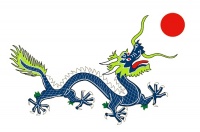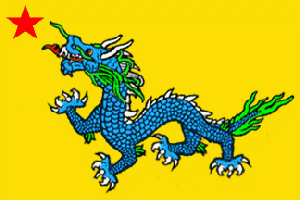Hunan

| |
| Language | Xiang |
| Capital | Changsha |
| Government Type | Constitutional Monarchy |
| King | Fùxīng |
| Currency | Yuan = 720 cash |
Hunan is a hilly landlocked Chinese nation. Formerly a bellicose communist nation, following the Cantonese War of 2003, it has become a quiet and stable constitutional monarchy.
History
Hunan has figured prominently in the history of China, in one form or another over the millenia
Early History
Anciently, Hunan's primeval forests were first occupied by the ancestors of the modern Miao, Tujia, Dong and Yao peoples. It entered the written history of China around 350 BC, when under the kings of the Zhou Dynasty, it became part of the State of Chu. After Qin conquered the Chu heartland in 278 BC, the region came under the control of Qin, and then the Han dynasty. At this time, and for hundreds of years thereafter, it was a magnet for migration of Han Chinese from the north, who displaced or assimilated the indigenous people, cleared forests and began farming rice in the valleys and plains.
Hunan and Hubei became a part of the province of Huguang (湖廣) until the Qing dynasty. Hunan province was created in 1664 from Huguang, renamed to its current name in 1723.
Hunan became an important communications center due to its position on the Yangzi River. It was an important centre of scholarly activity and Confucian thought, particularly in the Yuelu Academy in Changsha. It was also on the Imperial Highway constructed between northern and southern China. The land produced grain so abundantly that it fed many parts of China with its surpluses. The population continued to climb until, by the nineteenth century, Hunan became overcrowded and prone to peasant uprisings. Some of the uprisings, such as the ten-year Miao Rebellion of 1795–1806, were caused by ethnic tensions. The Taiping Rebellion began in the south in Guangxi Province in 1850. The rebellion spread into Hunan and then further eastward along the Yangzi River valley. Ultimately, it was a Hunanese army under Zeng Guofan who marched into Nanjing to put down the uprising in 1864.
Modern Era
Hunan was relatively quiet until 1910 when there were uprisings against the crumbling Qing dynasty, which were followed by the Communist's Autumn Harvest Uprising of 1927. It was led by Hunanese native Mao Zedong, and established a short-lived Hunan Soviet in 1927. The Communists maintained a guerrilla army in the mountains along the Hunan-Jiangxi border until 1934.
After the Great Pacific War of the 1930s and the 1940s, in 1952, Hunan was carved out of China by Australasia, the conquering power. In 1969, due to some popular dissent against the right wing government, a revolutionary leader, Wang Zhenli, took control. He combined Chinese nationalism with the teachings of Mao Zedong, the Hunanese communist leader, as Maoism-Wangism. While Wang believed in Marxism, he also claimed that a strong hand is needed to lead a country to full communism and that Shi Huangdi, the Emperor of the Qin Dynasty, was the first true communist.
He was quickly ousted, but restored in 1978, declaring himself Emperor of Hunan and of all China. In 1980, the newly declared Empire of Hunan attacked Nanhanguo, but were defeated. In 2003, it attacked Canton, kicking off the Cantonese War, and was again repulsed, with a nuclear device of some sort being detonated. Canton then occupied the land until June 1, 2003, when Japan took over the occupation.
Japan's occupation was more popular than Canton's, but it was not without its opponents. For the most part, however, the Hunanese seemed optimistic toward the establishment of a stable post-Wang government. In 2015 rumors built that the nation was soon to be given self-rule, and they were verified with the coronation of King Fuxing.
Geography
A mountainous country, yet historically heavily agricultural. Hunan was damaged by two (though initially reported as three) nuclear weapons. These weapons are alleged by the Hunanese to have been massive bombs -- calling them "dirty bombs" -- used to spread fissile material. Due to their hasty assembly from nuclear materials, and the unparalleled size of them, these bombs did indeed generate a mushroom cloud. The workmanship within, however was shoddy -- using Dalmatian detonators -- and didnot achieving fission, despite the Cantonese Army's best efforts. These dirty bombs were detonated over Xiangtan and Zhuzhou. The size of the bombs led affected soldiers and observers 1 to believe that they were fully-fledged nuclear weapons, causing extreme demoralization. The effects of these bombs has been reviewed in intervening years, and has been found to be less radioactive than the bomb used against Łódź -- however, the radioactive isotopes are still being collected and citizens are still being treated for their exposure to them.
Borders
Northwest: Nanhanguo.
West: Zhuanguo.
South: Canton, Meizhou.
East: Nanchang.
Politics
Hunan was, until recently, an officially Communist Dictatorship, with Wang Zhenli as emperor. It was governed by the Interim Administration of Hunan, with General Satò Aquira as Supreme Commander of the Occupation Forces until transition was completed in December of 2015.
Most former members of the Hunan Communist Party were purged from positions of authority. Japan worked hard to build a new local administration. Elections for an interim parliament were held in early 2006, and subsequent elections happened every two years. The interim parliament was entrusted with drafting a new constitution for Hunan, however this greatly delayed the transition to self-rule.
The shape the future government would take was the center of a lively debate, with proponents of republicanism, monarchy, constitutional monarchy, socialism, ecotopy, and others. One of the more interesting parties to arise was the Future-Imperial Party, which advocated the establishment of an Empire with the throne empty, awaiting the coming of a future Emperor of China, possibly the first political party to openly advocate an empty throne. Kenothronism enthusiasts watched this development with great interest, and there were reports of letter-writing campaigns to support this idea, although it was later revealed to be fruitless.
Among the constitutional monarchists, most advocated crowning a member of another Asian imperial or royal family, the most popular options being Nam Viet, Mÿqan̊ Ðaij and Japan, though some advocated crowning one or another Hunanese, or establishing an elective monarchy, like the Republic of the Two Crowns.
It was announced quietly in late 2014 that the monarchy would not be elective, but that the new king would be a scion of one of the surrounding royal families. In September 24, 2015, Hiroyuqui, Prince Comaçu of Japan, was enthroned as King.123
Fuxing Era
Under Fuxing, Hunan has begun to reach out to Tò-A-Rempò for inclusion as an observer. Efforts have also begun to mend fences with neighbors, and to attract businesses to the region.
Economy
The first internationally accepted trade in tea began with the harvests of 2016, making use of the Japanese Empire's distribution networks. Other formerly profitable industries are rising again, now that the country is on its way to a more settled future. Ramie production has increased now that trade restrictions have been removed, and is in increasing demand by the Japanese automotive industries.
